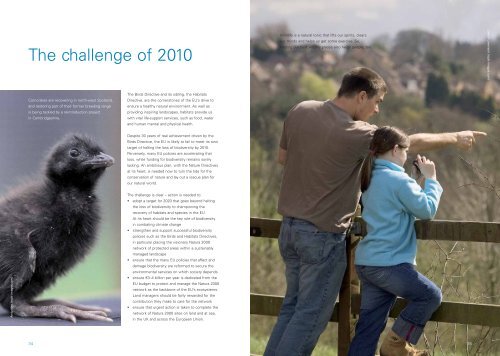The European Birds Directive - RSPB
The European Birds Directive - RSPB
The European Birds Directive - RSPB
Create successful ePaper yourself
Turn your PDF publications into a flip-book with our unique Google optimized e-Paper software.
<strong>The</strong> <strong>Birds</strong> <strong>Directive</strong> in action<br />
England: time for a Greater Thames<br />
Chris Gomersall (rspb-images.com)<br />
<strong>The</strong> Greater Thames Estuary combines essential<br />
elements of the natural world and human society in<br />
ways that put the <strong>Birds</strong> <strong>Directive</strong> to a real test.<br />
Can the framework of the <strong>Directive</strong>, developed three<br />
decades ago, provide a robust yet flexible tool to help<br />
sustainable development in the 21st century? <strong>The</strong><br />
<strong>RSPB</strong>’s analysis is that the <strong>Birds</strong> <strong>Directive</strong> has been<br />
instrumental in setting the context for the Thames and<br />
delivering some hugely encouraging outcomes.<br />
Reconciling the needs of the hundreds of thousands<br />
of wild birds that depend on the Thames Estuary for<br />
their survival, and the pressing needs of an expanding<br />
human population in London and on both shores of<br />
the river, was always going to be a challenge. Historic<br />
losses of coastal grazing marshes, the landscapes of<br />
Dickens, in the face of expanding human demands are<br />
well recorded. But the essence of the wild Thames<br />
remains into modern times.<br />
Ernie Janes (rspb-images.com)<br />
Greening the Gateway<br />
<strong>The</strong> Thames Estuary has seen many changes and this<br />
process continues. <strong>The</strong> <strong>RSPB</strong> is playing a leading role<br />
in the latest programme for change – the Thames<br />
Gateway. In support of the Parklands programme, the<br />
<strong>RSPB</strong> is creating 20 sq km of green space in Kent,<br />
London and Essex that is vital for the long-term<br />
conservation of the estuary’s wildlife and will be<br />
accessible to all. We support the objectives of<br />
establishing the Gateway as an exemplar of<br />
low-carbon growth and sustainable regeneration.<br />
<strong>The</strong> <strong>RSPB</strong> is bringing to life our Futurescapes vision of<br />
large-scale habitat creation for the Thames Estuary,<br />
recreating familiar landscapes and vital habitats. This<br />
will turn the area into a high quality environment for<br />
people and sustainable development along<br />
the Thames.<br />
<strong>The</strong> <strong>RSPB</strong> is convinced the central role that the natural<br />
environment of the Thames Gateway is now playing in<br />
establishing an “eco-region” is due in no small part to<br />
the recognition brought by designations under the<br />
<strong>Birds</strong> <strong>Directive</strong>. <strong>The</strong> Thames Estuary is demonstrably<br />
world class for wildlife conservation, and is designated<br />
to reflect that fact. This ensures the benefits to human<br />
society that come from a wild coast, protected and<br />
managed both for its wildlife and the people, can<br />
be achieved.<br />
Right: dark-bellied brent geese accompany a Thames<br />
winter walk with their yelping calls. Numbers have<br />
recovered in the Thames thanks to conservation<br />
measures driven by the <strong>Birds</strong> <strong>Directive</strong>.<br />
“<br />
<strong>The</strong> coast of the Thames Estuary has long inspired me and it<br />
convinces me that placing nature at the heart of a vision for<br />
change is one of the keys to sustainable regeneration in the<br />
Thames Gateway.<br />
”<br />
Sir Terry Farrell, Parklands Design Champion<br />
18<br />
19
















